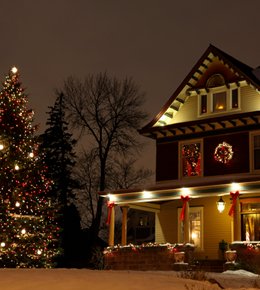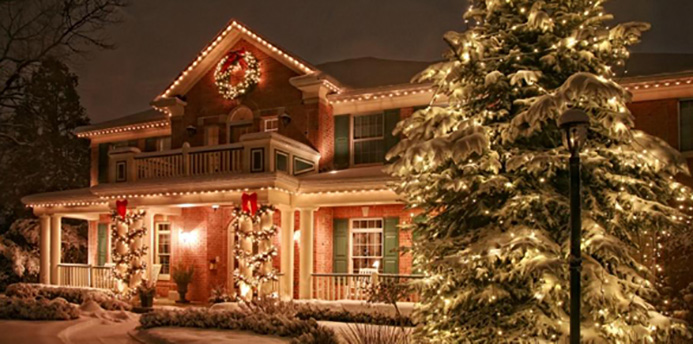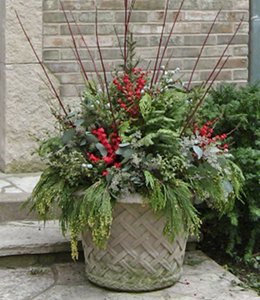 If your idea of outdoor holiday decorating is inspired by Clark Griswold in “Christmas Vacation,” more power to you.
If your idea of outdoor holiday decorating is inspired by Clark Griswold in “Christmas Vacation,” more power to you.
But if you’re looking for something less brazen, we’ve got the secrets to seasonal success.
Getting Ready To Light It Up
Hanging holiday lights is no easy task, so keep this in mind before you start:
- Test each strand before you hang it.
- Use timers that have an actual clock versus a sensor (depending on the location of your sensor, indoor lights or car headlights can trip and turn off the lights).
- Purchase plastic gutter clips for hanging lights along the eaves.
- Invest in LED lights. While upfront costs are higher, LED lights are durable, resist color fading, and are more energy efficient.
- Choose your trees so you don’t do damage. Avoid hawthorns, magnolias and birches.
- Find a GFI outlet and only use the recommended number of strands for the circuit. (If you’re planning a large lighting installation, make sure to contact an electrician to confirm available amps for the display.)
- Follow the manufacturer’s recommendation on how many lights can be strung end to end.
- Remember your ladder safety: always have a spotter and don’t go higher than your waist on the last ladder rung. If you can, try using extension poles for those hard to reach areas.
- Make sure your connections are tight. Some of our experts like wrapping the connections in electrical tape to keep moisture out. Others warn that wrapping them in tape can cause moisture to get trapped and blow the circuit, outlet and your lights. Your call.
- Install when the lights are lit so you can see where the lights are needed.
And to answer the age-old argument: white vs. colored lights. The general consensus is that white lights are more formal and twinkle brilliantly against the snow. But colored lights continue to be a sentimental favorite. Whatever you choose, stick with one or the other. Mixing colored and white strands, bulb sizes or styles gets a little too Griswold.
 Lighting Your Landscape Like A Pro
Lighting Your Landscape Like A Pro
If you’ve got the wherewithal to have someone else hang your lights, there’s no better gift to yourself. But if the job falls in your lap, keep these tips in mind:
- When designing holiday lighting, balance and symmetry will give you the most impact.
- Use your lights to frame the house, accent entryways or draw attention to the front door.
- Trees and shrubs should have the same lighting placement and contain the same number of lights to preserve symmetry.
- Instead of spreading lights all over the landscape, select key plants: shrubs flanking an entry, an ornamental tree at the corner of your home, or a stately shade or evergreen tree.
- Remember, you’ll get more impact if you concentrate on one area and do it right as opposed to trying to cover too large an area too sparsely.
For a classic look, try wrapping branches of ornamentals or shade trees versus wrapping the entire exterior of the plant. While more labor intensive, this method of wrapping the branches illuminates the natural structure of the tree.
Decking the Halls, Porches and Gates
Like icing on a cake, nothing finishes outdoor holiday decor like garlands and wreaths.
Our experts find that most clients prefer garland hung in a traditional manner, around front doors, draped on porch railings, fencing and gates. Wreaths are typically placed at windows and doors. As with the lights, keep it clean and simple and make sure your garland and wreath match or complement each other.
Garlands come in all sorts of flavors, so pick one that fits the style of your home. For example, a formal Georgian might look best with boxwood or magnolia, while white pine or a mixture of cedar, fir and pine would best suit a colonial or farmhouse.
Tips:
- If you’re trying to keep costs down, there’s nothing wrong with simple and sweet. As with lighting, more is not always better.
- For added sparkle, you can always string your garlands with lights, but keep to the rules of symmetry and balance.
- If you insist on going with fake, make sure to fluff up the garlands. Avoid straight angles and add a gentle curve at the end of each tip.
- Save yourself some dough and dress up a basic wreath with a custom bow (select a ribbon with wires so it holds its shape).
- And don’t forget the mailbox at the street. A little bit of ribbon and greens adds an extra holiday touch.
Simple Pot Solutions for the Novice Gardener
If you need to fill your pots but want to keep it simple, here are some terrific ideas that add color without too much green:
- For a simple, modern pot, lay a wreath on the top of a container, making sure it’s big enough to overhang the edge. Then form a bundle of red twig dogwood or curly willow, wrap it with a wire and cover the wire with a festive ribbon. Stick the bundle in the wreath hole and wedge it into the dirt (make sure it’s fresh, not frozen potting soil).
- If your container can withstand the weather, plant a small boxwood or evergreen. But remember, because it’s a living plant, you’ll need to water it throughout the winter.
- Even if you stick with the less expensive fillers, you can still make a beautiful pot. Visit your local garden center and purchase two different kinds of boughs (for example, white pine and balsam). After filling your pot with fresh dirt, start with balsam and insert the boughs facing upside down, so it overhands the edge. Next, grab your white pine and insert the boughs facing up. Alternating directions creates texture and fullness. Then pop in some finishing touches (like red twig dogwood, winterberries, even seedheads or dried hydrangea blooms from your garden).
- Whatever you use, keep it green all season with Wiltproof, available at most garden centers.
These talented landscape professionals provided the ideas and inspiration for this article:
Anne Flannery, The Beaded Garden
Chris Poggi, James Martin Associates
Michael Schmechtig, Schmechtig Landscapes
Robin Smith, Pasquesi Home & Garden
Donna Vignocchi, ILT Vignocchi
Marni Wilson, Mariani Landscape


